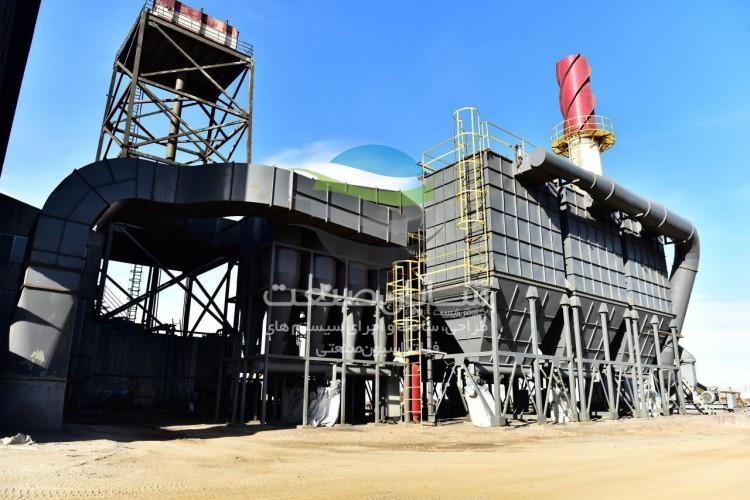Steps of installation of bag filter system
Install the bag filter system
Depending on the type of bag house selected, the initial operational setup and installation can take from a few days to several months. Following the correct instructions in any case can be effective in saving time and money, and will also be useful for future maintenance and repair of the bag house system.
Proper coordination between the bag house designer and the installation staff will help maintain the bag house function for years. Listed below are some of the key features that the installation operator should consider during the installation period:
• Easy access to all storage areas of fans, motors, drain valves, solenoid valves, dampers, bag monitors
• Easy access to all test and inspection areas – Chimney test ports and continuous release monitors
• Baghouse weather conditions must be able to withstand harsh weather conditions such as rain or snow.
The following features are suggested for a bag house that is properly designed and installed
Uniform air and dust distribution for all filters:
Dust design and plate deflection all contribute to uniform gas distribution. If these equipments are not installed properly, by inducing areas of high gas flow, they cause dust or wear of bag filters, and by inducing areas with high concentration of dust, they can produce unfavorable hopper load and uneven dust cake cloth filter.
Ventilation and general flooding of the system from dust to the flue outlet.
No air leakage in flanges, collectors, communication channels, seams and welds, etc.
Effective coatings and staining
Unprotected putties allow corrosion to occur and require sandblasting, leading to costly repairs for facility operators.
Properly installed bag filters
Bag filters are the heart of any fabric filter system. Improper installation can lead to rapid bag failure, reduced cleaning efficiency, high pressure drop and increased operating costs or increased flue emissions. Each manufacturer provides instructions for the proper installation of the bag filter, which must be followed explicitly. Often, the initial disadvantages of bags are due to improper installation. It is easier for installation technicians to first check the connections of bags, etc. in a dry, cool, and clean collector, rather than having to do such checks the day after commissioning. Bag maintenance usually takes up 70% of the time and cost of annual maintenance. Further efforts in this area can have a greater impact during installation.
Proper installation of insulation
Insulation is typically used to prevent maintenance problems on high temperature collector systems. When working with high temperature gases, it is very important to maintain the temperature of the gas and all the components of the collector that come in contact with it, above the gas dew point. The installer should check that all surfaces and areas prone to heat loss are properly covered. In practice, one must be careful of cold spots that cause local corrosion. Excessive heat loss can increase the warm-up time or decrease the gas temperature below its dew point.
General sealing between the clean side and the dirty side of the collector
Remember that the primary purpose of the dust collector is to separate particles and special materials from the gas by fabric filtration. This means that all the gas must pass through the fabric. Any leakage through the fabric filters directly emits dust from the chimney and thus reduces the collection efficiency of the system. It is time to monitor the leak before the start-up, when everything is clean and accessible. The best technique is to use a bright light on one side of the occupied space and visually observe the penetration of light to the other side. This is the most effective method in total darkness. The installer should allow extra time to check this important area. After initial commissioning, it can be very difficult to check for leaks from the bottom of the chimney that are not due to bag defects.
Operating dampers and their correct installation
Most systems use multiple dampers to separate system areas or control volume and air flow. It is important to adjust and align both internal blades and their operational connection. Leaks through dampers can lead to improper cleaning of bags. This can also create unfavorable environmental conditions for maintenance workers to work in this area and even lead to a threat to their health.
Appropriate operational mechanical components
Most mechanical components are designed under a normal operating trajectory. The location of the cylindrical rod, the rotation of the motor, etc. should be checked.
Fans in operation
For better fan rotation, the alignment and adjustment of the moving parts and the correct vibration of the fan should be checked. The fan must be securely mounted on a suitable object to prevent additional vibration.
Dense, dry and clean air
Most systems use compressed air for the operation of dampers, controls, installations, etc. Many systems are likely to have problems shutting down and maintaining the device due to poor air quality. Clean dry air is essential for proper operation of pneumatic components. During installation, a desiccant drying system is usually used where the ambient air drops below 32 degrees Fahrenheit. Sometimes the installation of overhead lines and pneumatic components will be required. Often, such considerations are not taken into account in the dust collector system with clean, dense, dry air supplied by the owner. Note that when the air reaches the pneumatic components, it must be dry and clean.
Humidity in compressed air first disrupts the operation of jet pulse and book solenoid valves, then closes the vents and springs of the bags, resulting in them becoming muddy and a decrease in fan suction, and finally disrupting the outlet transmission system. Soot includes screws and rotary.

